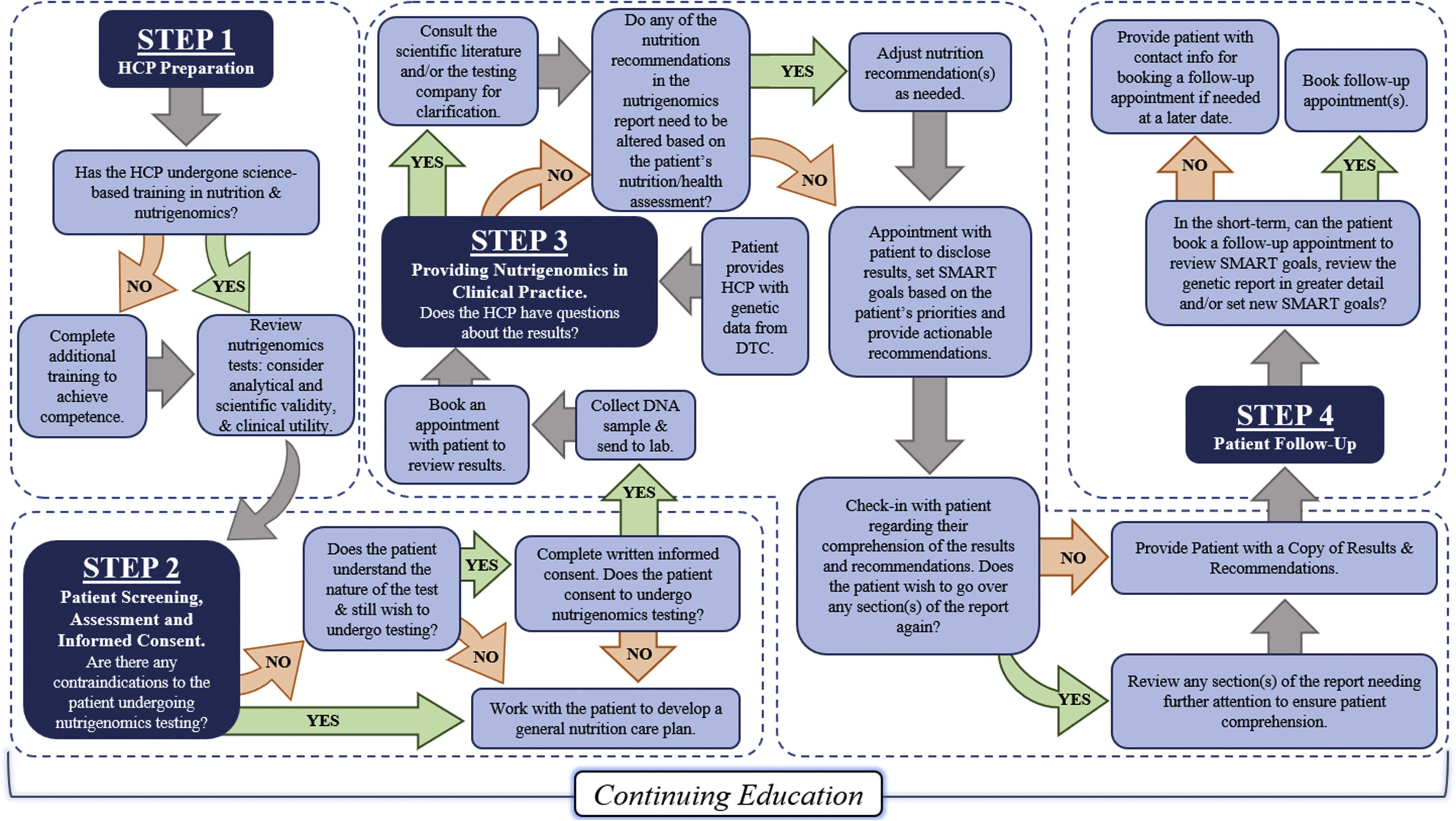A recent statement from the American Nutrition Association declared that “personalized nutrition is the most powerful antidote to chronic disease,” while the Academy of Nutrition and Dietetics’ 2017 Visioning Report stated that dietitians “can assume an increasingly important role in the emerging health care system that focuses on genetic testing.
While the practical use of nutrigenomics still remains a topic of debate, it is becoming more common in clinical practice with patients bringing direct-to-consumer nutrigenomics reports to HCPs for interpretation, and some HCPs offering nutrigenomics tests to their patients.
However, a new report by nutrigenomics researchers, published in Journal of the Academy of Nutrition and Dietetics, notes that HCPs currently lack clinical guidance documents in nutrigenomics. As a first step in changing this, the researchers developed a care map to provide HCPs with a tool for considering nutrigenomics in clinical practice.
The care map was developed by an expert advisory panel consisting of six nutrigenomics researchers, three of whom are also registered dietitians (RDs), after consulting nutrigenomics literature and incorporating the three key pillars of personalised nutrition.
The draft was reviewed by 12 HCPs with representation from six continents (Africa, Asia, Australia, Europe, North America, and South America) who have experience using nutrigenomics in their clinical practice.
A 4-step care map was developed, with sections related to HCP training in nutrigenomics (Step 1), patient screening, assessment and informed consent (Step 2), providing nutrigenomics in clinical practice (Step 3), and patient follow-up (Step 4). Continuing education was incorporated throughout the care map.
Step 1 - Training
The paper discusses the importance of HCP's firstly ensuring they have undertaken additional training in this area. Clinical practice guidelines (CPGs) do not yet exist for nutrigenomics yet they are important to clinical practice as they help to provide a clear summary of evidence available.
"In addition to having a strong background in evidence-based nutrition and ethical health care practices, HCPs should seek to have confidence and competence in their knowledge of basic genetics, legal considerations relevant to genetic testing, and clinical interactions with patients undergoing nutrigenomics testing," the guidance states.
"Several resources exist for HCPs to further their knowledge in nutrigenomics, including more than 35 courses offered globally ranging from short online presentations to university-level courses and graduate degrees."
Step 2 - Patient screening
The guidance states that before undergoing nutrigenomics testing, all patients should be screened to identify their current health, their needs, their targets, and their ability to undergo nutrigenomics testing.
It states: "The HCP also has a responsibility to consider cost–benefit of genetic testing, taking into account the patient’s reasons for wanting to pursue testing, financial willingness and ability, and health status/family history. When cost–benefit justification is not met, or there is no evidence to support the use of a particular genetic test in a subset of the population, or significant contraindications exist, then the HCP has a responsibility to advise the patient against proceeding with nutrigenomics testing."
Although DTC companies have informed consent processes at time of purchase, when genetic testing is done through HCPs, the HCP is responsible for obtaining the informed consent from all patients before they undergo nutrigenomics testing.
The advice is that the consent process should include information related to the nature of the test and recommendations, pros and cons of the test, information related to privacy, potential added value to the nutrition care plan, and legal implications, such as the potential for genetic discrimination in some countries or obligations to disclose the results of certain genetic tests.
Step 3 - Providing nutrigenomics
When it comes to reading the nutrigenomic test results and discussing these with the patient, the advice is that these should be considered alongside anthropometric, biochemical, clinical, and dietary intake data.
"The HCP should consider phenotype and/or blood work results in conjunction with nutrigenomics results. For example, if a patient’s nutrigenomics report indicates an elevated risk for lactose intolerance but the patient exhibits no signs or symptoms of gastrointestinal discomfort, then it may be unnecessary for the patient to limit their intake of lactose-containing products."
The guidance is that the HCP and patient should work together to identify 1 to 3 specific, measurable, attainable, relevant, and time-based (SMART) goals for the patient to focus on. Additional resources, such as recipes, handouts, and digital tools (including apps), can also be provided or recommended to the patient as needed
Step 4 - Patient follow-up
The purpose of a follow-up appointment is to review the patient’s progress (with respect to nutrition habits and changes in any measured biomarkers), answer any questions the patient may have, review priority areas of nutrition care, review SMART goals set in the previous session, and set new SMART goals if the patient is ready.
Source: Journal of the Academy of Nutrition and Dietetics
Horne, J. R., et al
"Guiding Global Best Practice in Personalized Nutrition Based on Genetics: The Development of a Nutrigenomics Care Map"





